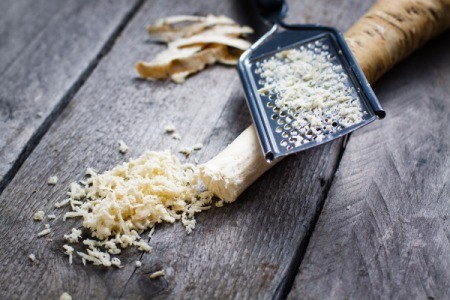If you like strong flavors, horseradish is one of the healthiest and most versatile perennial herbs to grow. The roots are easy to grow and prepare, and when harvested fresh from the garden, pack a much larger punch than the varieties found in grocery stores.
Tips for Growing
Horseradish is a perennial member of the mustard family, cultivated for its fleshy, pungent white roots. It prefers to grow in full sun to partial shade and will tolerate almost any soil. Seldom grown from seed, root cuttings are set in the ground in early spring (March or April) and ready for harvest by fall.
- Horseradish plants love to wander and once established can quickly become a nuisance. This can be avoided by growing the roots in bottomless 5 gallon containers sunk into the ground.
- Prepare the soil 12 inches deep before planting.
- Set root pieces in the ground at a 45 degree angle, with the tops about 2 inches below the surface.
- Space individual cuttings 12-18 inches apart so they have plenty of room to widen as they grow.
- Spikes of tiny, white flowers appear on horseradish plants in late spring to early summer. Remove these to keep the plant's energy focused on leaf and root production.
- Although the plants will keep coming back year after year, the roots tend to become woody with age. Roots that are 1 to 2 years old usually have the best flavor.
- Roots are not the only edible part of the horseradish plant. Tender, young leaves can add a delicious zing to garden salads.
Tips for Harvesting
- Horseradish can be harvested in the spring or fall. Many gardeners claim that harvesting roots in the fall after a couple of good frosts really enhances the flavor. When the tops of the plants die back in late fall, it's a sign that the roots are ready for harvesting.
- Make sure you wear gloves when handling the roots. They contain oils (much like hot peppers) that can irritate your skin.
- Use a trowel or shovel to dig the roots clear. Break or cut off as much of the root as you need and replace the soil.
- With a layer of mulch for protection, you can leave the roots in the ground and continue to harvest them over winter.
- Protect harvested roots from light to prevent them from turning green, and allow them to dry for a few days before storing them.
- Store your unwashed roots in a cool, dry basement, or in the vegetable drawer in your refrigerator. Roots will keep for approximately 3 months at 32 to 38 degrees before turning bitter.
How to Prepare the Roots
Making prepared horseradish consists of 5 basic steps:
- Wash and peel the roots.
- Chop the roots into small pieces.
- Add the pieces to a blender, along with a few ice cubes and a small amount of cold water (just enough to cover the blades).
- Puree roots to desired consistency.
- When the roots reach the desired consistency, add 2 or 3 tablespoons of distilled white vinegar and 1/2 teaspoon of salt for each cup of grated horseradish (see below for timing).
Adding Vinegar: Timing is Everything
Horseradish root does not give off a strong taste and aroma until it is grated or ground. Only after the tissues come into contact with oxygen are the volatile compounds, which develop the flavor, released.
Adding distilled vinegar to the freshly grated root stops the chemical process and allows you to control the "heat" of the final product. For milder horseradish, add vinegar to the root as you puree them. For a stronger flavor, puree the root first and wait a few minutes before adding vinegar.
Additional preparation tips:
- To make a creamy horseradish, mix in mayonnaise after adding the vinegar. You may also want to experiment by adding in cream, sugar, and other spices to taste.
- Add color to your prepared horseradish by adding in some beets as you puree raw roots.
- As an alternative to white vinegar, try using rice wine vinegar or mixing in some lemon juice and salt to taste.
- When preparing fresh horseradish root, make sure you are in a well-ventilated area. The strong aroma produced can easily irritate your eyes and sinuses.
- Store horseradish in the refrigerator in tightly covered glass jars. Prepared horseradish will keep in the refrigerator for several months. When it starts to darken and lose its flavor, it's time for a new batch.
